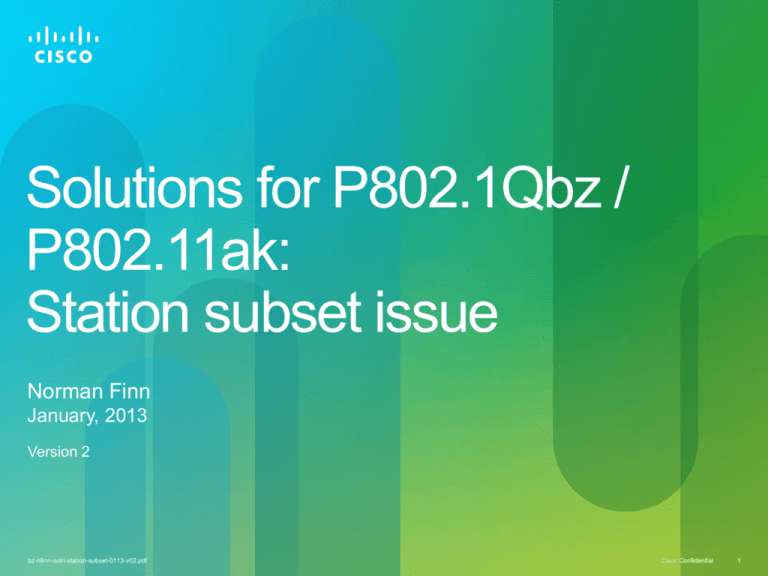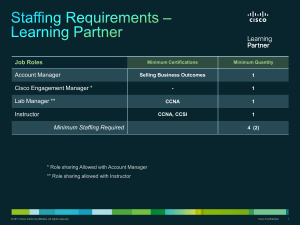
Solutions for P802.1Qbz /
P802.11ak:
Station subset issue
Norman Finn
January, 2013
Version 2
bz-nfinn-soln-station-subset-0113-v02.pdf
Cisco Confidential
1
• This presentation is available at:
http://www.ieee802.org/1/files/public/docs2012/bz-nfinnsoln-station-subset-0113-v01.pdf
• It attempts to answer one of the questions raised by:
http://www.ieee802.org/1/files/public/docs2012/bz-nfinn-ptto-pt-problem-list-1112-v02.pdf
bz-nfinn-soln-station-subset-0113-v02.pdf
Cisco Confidential
2
• AP sends the “same” multicast from X to stations behind
station/bridges A through E.
• But, tagging differences and VLAN translations result in three
different resultant frames, and at least three transmissions: VID 6
(A and B), VID 7 (C), and untagged (D and E).
• How do we send each one to the right subset of stations?
tagged
with VID
6 or 7
X
6
A
6
B
bz-nfinn-soln-station-subset-0113-v02.pdf
AP/B
7
C
untagged
D
E
Cisco Confidential
3
© 2010 Cisco and/or its affiliates. All rights reserved.
Cisco Confidential
4
• 802.11 defines four addresses for every frame:
Receiver Address: Which station(s) (AP or non-AP) should receive
frame.
Destination Address: Destination address in original MAC service
request.
Source Address: Source address in original MAC service request.
Transmitter Address: Which station (AP or non-AP) that transmitted
frame.
• Typically, AP and non-AP stations use only three addresses
per frame, by using formats that combine two addresses
into a single 6-byte field:
UP TO AP: Receiver (the AP), Destination, Source = Transmitter
(non-AP).
FROM AP: Receiver = Destination (non-AP), Source, Transmitter
(the AP).
Which, of course, is the root of the “reflection” problem.
bz-nfinn-soln-station-subset-0113-v02.pdf
Cisco Confidential
5
• If you simply use all four addresses for exactly the purpose
described in 802.11, this problem can be solved.
• The key is the definition of the Receiver address:
Receiver Address: Which station(s) should receive frame,
• And to notice that the Receiver Address can be a multicast
address.
• Each non-AP (or AP) station attached to the transmitting AP
“subscribes to” (accepts frames containing) some multicast
Receiver Addresses (the right ones) and discards frames with
other multicast Receiver Addresses (the wrong ones).
bz-nfinn-soln-station-subset-0113-v02.pdf
Cisco Confidential
6
© 2010 Cisco and/or its affiliates. All rights reserved.
Cisco Confidential
7
• The A-MSDU described in 802.11n is a three-address frame (on
the outside) that carries any number of encapsulated frames.
• The encapsulated data frames’ Destination and Source
addresses are internal to the frame, and not used in the outer
three address fields.
• The outer Source/Transmitter address can be used by a
transmitting non-AP station bridge to discard reflections, using the
Source address of the reflected frame, in exactly the same way it
discards them, now.
• The outer Destination and Receiver addresses are always the
AP/Bridge on frames sent towards the AP, and the
Destination/Receiver address on frames sent by the AP is a
multicast address denoting some subset of the non-AP stations.
bz-nfinn-soln-station-subset-0113-v02.pdf
Cisco Confidential
8
© 2010 Cisco and/or its affiliates. All rights reserved.
Cisco Confidential
9
• The AP and its attached stations have to agree on what to use for
the multicast Receiver (four-address alternative) or
Receiver/Destination (A-MSDU alternative) addresses.
• We have to make sure that existing non-AP stations will not do
the wrong thing when they receive frames containing multicast
Receiver addresses that are not the broadcast address.
bz-nfinn-soln-station-subset-0113-v02.pdf
Cisco Confidential
10
• There is a protocol described in IEEE Std 802.1BR for distributing
a mapping between multicast MAC addresses and a list of
delivery ports (e.g. for non-AP stations S1, S2, …):
MAC address
S1
S2
S3
S4
S5
S6 S7
…
01-80-C2-XX-00-01
Y
Y
N
N
Y
N
Y
…
01-80-C2-XX-00-05
Y
Y
Y
N
Y
Y
Y
…
01-80-C2-XX-00-12
N
N
N
Y
Y
N
N
…
…
…
…
…
…
…
…
…
…
• Distributing the vectors has problems with delays that are similar
to the delay problems when distributing MAC address mappings
in the proposal by Zhuang and Wang (document 12-1449).
• These problems can be minimized by suitable rules regarding
what kinds of changes can be made to the vector list.
bz-nfinn-soln-station-subset-0113-v02.pdf
Cisco Confidential
11
• One easy solution, very similar to what is often done, today:
• Non-AP stations that expect frames without a VLAN tag, and that
do not understand multicast Receiver addresses, use different
SSIDs, one per VLAN.
• Non-AP stations that understand VLAN tags, but do not
understand the new multicast Receiver addresses, can all go on
one SSID, different from the above (but could use the above
SSIDs.
• New non-AP stations that understand multicast Receiver
addresses, whether bridges or not, must go on one SSID,
different from all of the above.
• Some day, when all stations understand multicast Receiver
addresses, only the last SSID is needed.
bz-nfinn-soln-station-subset-0113-v02.pdf
Cisco Confidential
12
• It was mentioned in the architecture solutions deck (see
references) that bridging makes no demands on an AP for
behaviors not already exhibited by many APs.
• The use of multicast Receiver addresses does introduce a new
behavior.
• Before, the AP used destination MAC address and VLAN ID to
select the security association on which to transmit a frame.
• Now, the AP must do the above, but must also use that
information, plus the ingress port (security association ID), in
order to select the Receiver MAC address.
bz-nfinn-soln-station-subset-0113-v02.pdf
Cisco Confidential
13
© 2010 Cisco and/or its affiliates. All rights reserved.
Cisco Confidential
14
• The AP generates and maintains a list of addresses and distribution
vectors as shown in the table, above.
• Each non-AP station maintains only a vector with one bit per multicast
Receiver address (they are all in a relatively small range), stating
whether that station accepts frames with that address, or not. Bits for
unknown addresses are 0. It does not bother to remember the vectors.
• When a vector is created, changed, or deleted, the AP sends messages
to update the stations as necessary, and retransmits as necessary, until
all notified stations have acknowledged the update.
• A vector can be used by the AP before the acknowledgements are
received (or even before the notifications are sent), due to these rules:
A station can be added, but never removed, from an existing address’s vector.
A vector can be deleted, and after all ACKs are received, the address can be
redefined with any value.
• With these rules, when the vectors change, extra frames will likely be
discarded, but none will be relayed when they should not be.
bz-nfinn-soln-station-subset-0113-v02.pdf
Cisco Confidential
15




